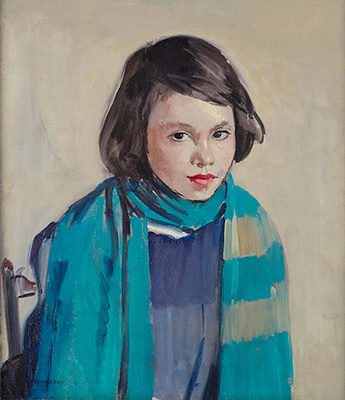
Philip Naviasky
The Blue Scarf, 1930s
Oil on canvas
22 ¾ x 20 inches, 58.5cm x 51cm
Philip Mould & Co.
To view all current artworks for sale visit philipmould.com Best known for his enigmatic portraiture, Philip Naviasky can now be regarded as one of the most understated yet technically...
To view all current artworks for sale visit philipmould.com
Best known for his enigmatic portraiture, Philip Naviasky can now be regarded as one of the most understated yet technically accomplished Modern British artists who worked outside of the capital.
The son of Polish immigrants, Naviasky won a scholarship to the Leeds School of Fine Art in 1907 at the age of just thirteen, before being accepted into the Royal Academy Schools just five years later, the youngest ever student. After winning a Royal Exhibition Award Naviasky went on to study at the Royal College of Art, before taking up a post as an art teacher at the Leeds College of Art. Only recently gaining the recognition he deserves, the portraits of Philip Naviasky represent a bold way of depicting a society and era full of uncertainties, in a way which stands quite independent from the more well established and reputed artists working in the London schools.
Although painting many fine landscapes, Naviasky is perhaps best regarded for his portraiture and its timeless depiction of the rapidly changing styles and fashions of the time. He painted many prominent figures, including Ramsay MacDonald (1866-1937), Labour’s first Prime Minister, but many of Naviasky’s sitters were selected mainly for their interesting features; his works more often than not focus on themes as opposed to personal identities.
Naviasky’s decision to work in Yorkshire is perhaps responsible for his slow emergence to the rank of greatness, for, undeniably, artists working in London such as Augustus John (1878-1961) by this point held a dominating position in the market for portraiture. That is not to say however that Yorkshire didn’t also embrace and encourage the arts, and Naviasky, along with several other contemporaries, benefitted greatly from a number of key and influential patrons connected to industry.
The present work exemplifies Naviasky’s technique of combining patches of bold, saturated colouring against plain backgrounds in a way that illuminates his subjects. Naviasky’s technical accomplishment can be further appreciated in the way these two seemingly different colour choices blend with each by the use of corresponding colour on the girl’s scarf.
Best known for his enigmatic portraiture, Philip Naviasky can now be regarded as one of the most understated yet technically accomplished Modern British artists who worked outside of the capital.
The son of Polish immigrants, Naviasky won a scholarship to the Leeds School of Fine Art in 1907 at the age of just thirteen, before being accepted into the Royal Academy Schools just five years later, the youngest ever student. After winning a Royal Exhibition Award Naviasky went on to study at the Royal College of Art, before taking up a post as an art teacher at the Leeds College of Art. Only recently gaining the recognition he deserves, the portraits of Philip Naviasky represent a bold way of depicting a society and era full of uncertainties, in a way which stands quite independent from the more well established and reputed artists working in the London schools.
Although painting many fine landscapes, Naviasky is perhaps best regarded for his portraiture and its timeless depiction of the rapidly changing styles and fashions of the time. He painted many prominent figures, including Ramsay MacDonald (1866-1937), Labour’s first Prime Minister, but many of Naviasky’s sitters were selected mainly for their interesting features; his works more often than not focus on themes as opposed to personal identities.
Naviasky’s decision to work in Yorkshire is perhaps responsible for his slow emergence to the rank of greatness, for, undeniably, artists working in London such as Augustus John (1878-1961) by this point held a dominating position in the market for portraiture. That is not to say however that Yorkshire didn’t also embrace and encourage the arts, and Naviasky, along with several other contemporaries, benefitted greatly from a number of key and influential patrons connected to industry.
The present work exemplifies Naviasky’s technique of combining patches of bold, saturated colouring against plain backgrounds in a way that illuminates his subjects. Naviasky’s technical accomplishment can be further appreciated in the way these two seemingly different colour choices blend with each by the use of corresponding colour on the girl’s scarf.
Be the first to hear about our available artworks
* denotes required fields
We will process the personal data you have supplied in accordance with our privacy policy (available on request). You can unsubscribe or change your preferences at any time by clicking the link in our emails.